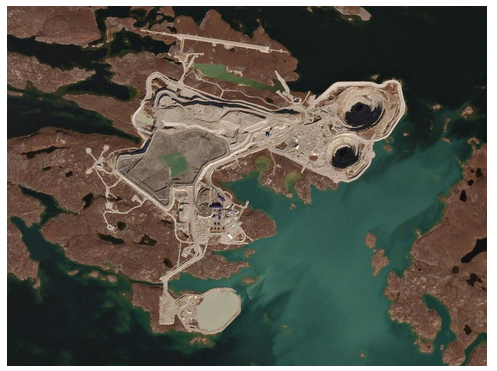9.1.1: Mineral Resources
- Page ID
- 18482
Earth gives us many mineralogical resources, also called mineral commodities. Fewer than a dozen minerals and eight or nine elements dominate the crust – we use most of them in our daily lives. Other elements and minerals that exist only in small amounts and have uneven distributions, are equally vital. We mine some ores because they contain elements that have the metallic properties of conductivity, strength, or shiny appearance. We mine industrial minerals such as halite, gypsum, clays, calcite, asbestos, micas, and zeolites to make salt, plaster, ceramics, construction materials, electronic components, chemical filters, and many other things. We also quarry large quantities of limestone (to make cement) and building stone, and energy companies produce large amounts of coal, oil, gas, uranium and other energy resources.

We mine diamond and other potential gem minerals for jewelry and also for use in industry. The photo in Figure 9.2 shows the Diavik Diamond Mine in remote Canada. This mine has produced about 10 million carats of rough diamond since it began operations in 2003.
When we think of diamonds, we generally think of gems, but gem diamonds are rare. Most natural diamonds, called industrial diamonds, have little gem quality. Because of diamond’s great hardness, industrial diamonds have many important uses. Most commonly they are used as an abrasive or polishing agent. But they are also incorporated into grinding wheels, saw blades, and drill bits used to manufacture products from very hard materials. Thus, diamonds and many other mineral commodities are used in many different ways.
Ore deposits and ore minerals fall into several main commodity groups: metallic and semimetallic elements, nonmetallic elements, gems, construction and manufacturing materials, fertilizer and chemical minerals, and energy resources (table below). We take energy resources and construction materials from Earth in the greatest quantities. We also mine large amounts of salt and fertilizer components. Of the metals, only iron is removed from Earth at rates comparable to these components.
| group | examples |
|---|---|
| metallic and semimetallic elements | gold, silver, copper, iron, manganese, aluminum |
| nonmetallic elements | potassium, sodium, phosphorous, sulfur |
| gems | diamond, sapphire, agate |
| industrial materials: construction and manufacturing | sand, clay, building stone, diatomite, talc, mica, zeolites |
| industrial materials: fertilizer and chemicals | limestone, phosphate, potash, salt, nitrate, fluorite |
| energy resources | coal, oil, gas, uranium |
Many different mineral commodities are important to modern society. However, when mineralogists think about mining, they are generally thinking of ore minerals that are the sources of important metals, or of minerals that have specific, highly valued properties (e.g., asbestos, micas, potash, and gems of all sorts). That is what we will focus on in most of the rest of this chapter.


